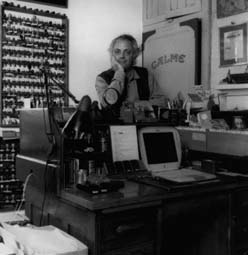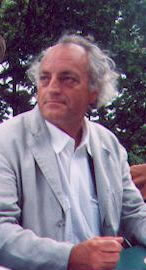Secrets des brumes
C’est en marchant, surtout dans la fraîcheur matinale, c’est sans cesser de marcher que l’on pourra poser la question de l’ « art » ou de « la poésie », plus exactement la rencontrer et non pas la poser, comme on fait d’un sac au cours de la marche, car elle serait à la lettre dépassée aussitôt de n’être que posée et non poésie :
par la marche Bashô ouvrit un espace à la poésie osée, mise en mouvement, prolongée, projetée, et dans ses pas c’est-à-dire en cortège, en collège épars, viennent ceux qui portent avec lui ses réponses interrogatives ;
par la marche Basho engage à aller dans l’Ouvert, à interroger plus avant, et telle est à sa suite la démarche lumineuse de Kaïdin qui, en son nom propre (avec les habits neufs de Khaî-Dinh, dernier empereur du Viet-Nam, ce grand clignotant, qui ne dédaignait pas d’orner d’ampoules électriques ses habits de fête), poursuit son itinérance depuis la forêt de Taï, la forêt primitive de Côte d’Ivoire, et rejoint la la Fête des Cerisiers et la Contemplation des fleurs : « nomade » est dès lors cette question même, s’éloignant à chaque pas plus encore de l’art du chevalet et des galeries :
la marche de l’art s’oppose au marché de l’art, s’oppose même aux Earthworks du Land art, qui posaient au loin dans le désert quelque trace énorme et définitive ; l’avancée au contraire n’a lieu que d’être délicate, éphémère, un rocher dont Kaïdin garnit de plumes d’oiseau mort les dix-sept cavités (comme les 17 syllabes d’un haïku) et de quelques baies rouges d’automne (à la façon des feuilles et les fleurs agencés par Andy Goldsworthy ou Nils Udo, par Richard Long sur quelques kilomètres de sentiers longeant une rivière nommée Le Talent) ;
or l’avancée est l’invention, progression, enjeu que saisit le verbe satoru, à la fois « comprendre » et « réaliser », accès au sens élevé de l’évéil, satori : cette rencontre où le monde se couvre du Manteau d’hiver de Matsushima quand l’installation éphémère de Kaïdin rejoint (et non pas illustre, mais réalise) le haïku de Bashô qui n’a su que dire « Ah Matsushima – Mastsuhima aH – Ah Matsushima », rencontre qui a lieu sur la sente étroite du bout du monde — où ça clignote.


Secrets in the mist
It is by walking, preferably in the early morning cool, it is by walking on that “art” or “poetry” will be questioned, more precisely will be encountered and not questioned once and for all as a bag would be put down during a walk, because the question would be outdated the moment it would only be asked and not kept open into poetry: by walking,
Bashô opened a space to daring, moving, extended, projected poetry, and in his footsteps in scattered processions and associations come the ones who convey with the poet his questioning answers ; by walking, Bashô encourages Open-mindedness, deeper investigation, and such does, after him, the bright process of Kaïdin who, in her own name (borrowing the new dress of Khai Dinh, the last emperor of Vietnam, this great indicator who would decorate his formal dress with bulbs) wanders on from the Taï forest, the primary tropical forest in Ivory Coast, to Hanami and the Cherry Blossom Festival: “nomad” is then the whole point, as step after step one gets further away from the art of the easel and of exhibitions: the art advance is at odds with the art market, is at odds even with the Earthworks of Land Art which left some enormous and permanent trace far in the desert ; on the contrary advancing only happens to be delicate, ephemeral, the seventeen holes (like the 17 syllables of a haiku) in a rock that Kaïdin fills with feathers from a dead bird and with some autumn red berries (in the manner of the leaves and flowers laid out by Andy Goldsworthy or Nils Udo, by Richard Long on kilometres of paths along a stream called Le Talent); now, advancing is inventing, progressing, a stake expressed by the verb satoru meaning both “understand” and “achieve”, an access to lasting enlightment, satori: this encounter when the world is wrapped in the Winter coat of Matsushima, when Kaïdin’s short-lived installation is in keeping with (and does not illustrate but achieves)
Bashô’s haiku which could only say
“Ah Matsushima-Matsushima aH-Ah Matsushima”,
an encounter occurring on the narrow road to the interior-where it is flickering.
(Translation of Alain Borer’s text Secrets des brumes)


「芸術」あるいは「詩」について疑問を提起できるのは、歩きながら、特に朝の爽やかな空気の中で、たゆまず歩み続けながらだ。
もっと精確には、徒歩の途中にリュックを置いて休むように疑問を静かに立てるのではなく、疑問に出会いに行く。
というのは疑問はただ提起された状態で文字どおり抜き去られるからだ。
しかし詩は異なる。歩くことで芭蕉は、大胆な、動きのある、時空に広がり、投影される詩の領域を開いた。
そして彼の足跡に、連れ立って、あるいはばらばらに、彼とともに問うような答えを持つ者たちが到来する。
歩くことで芭蕉は、開かれた中へ入り、一層深く問うことに身を投じた。 コート・ジボワールの原始の森、タイの森以来自らの道を追求し、そして桜祭と花見へ到ったカイディン、
(べトナムの最後の皇帝、祝賀の服に電球を飾ることまでした偉大な光り瞬いたカイディン帝の新たな服をまとうその名の)彼女の明快なアプローチはこのような芭蕉に続くものだ。
「放浪」はすなわちこの質問そのものである。一歩づつなおも画架と画廊のアートから離れ、そのアートの歩みはアートの市場に、そして遠く砂漠の中に巨大で断固とした跡を印したランドアートの「アースワーク」とさえも対立する。
前進は逆に繊細で束の間であることにしかない。カイディンの(俳句の17音のように)17の窪みに(アンディー・ゴールズワージーまたはニルス・ウドが行った葉と花の組み合せ、そしてリチャード・ロングがタレント川に沿った何キロもの小道にしたそれのように)鳥の羽と秋の赤い木の実を飾った岩。
すなわち前進は、考案、発展であり、「理解し」同時に「実感する」という「悟る」という動詞に把握されるもの、高い次元の目覚め、「悟り」への道なのだ。
それは出合い、カイディンの束の間のインスタレーションが、「松島や ああ松島や 松島や」としか言えなかった芭蕉の俳句に(イラストをつけたのではなく具現して)合流し、世界が「松島の冬のコート」を着る出合い、世界の果ての細い小道で起きる出合いであり、そこで光が瞬くのだ。
アラン・ボレル


